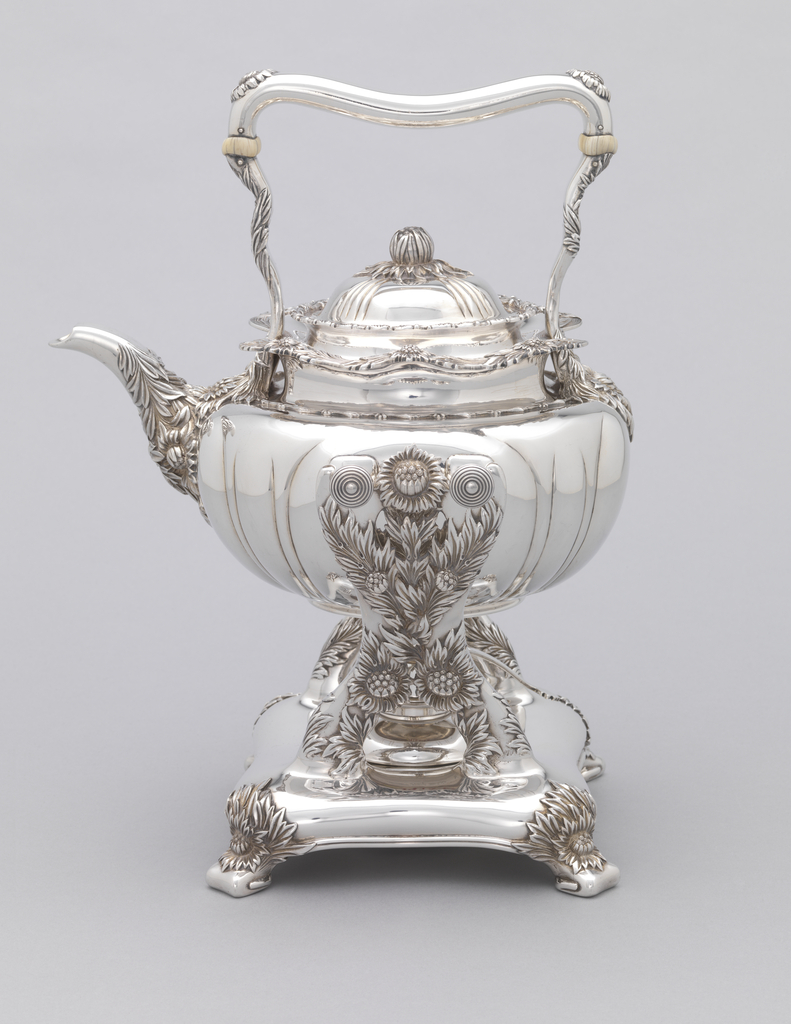This tea set, comprised of a kettle on a stand, coffee pot, tea pot, sugar bowl, and waste bowl, was given to the museum by Mrs. Roswell A. Miller, formerly Margaret Carnegie. The initials “RMA” are engraved on the pieces, signifying the owner of the elaborately decorated set. Margaret and Roswell were married on April 23, 1919, at her father’s, Andrew Carnegie’s, mansion on 91st Street and Fifth Avenue—now the site of the Cooper-Hewitt Museum.
The set, made by Tiffany & Co. between 1891 and 1902, consists of squat, globular forms, foliate feet, and fine repoussé work of chrysanthemum flowers. The Chrysanthemum pattern was designed by Charles T. Grosjean (1841-1888) in 1880. Grosjean was responsible for several innovative designs for Tiffany & Co. at the end of the nineteenth century. The pattern, patented on September 21, 1880, is rich with flowing shells, flowers, and foliage—representative of the Rococo Revival style. The forms have all-over decoration, except for an open area at one end to leave space for monogramming. Mr. Miller, in typical Victorian manner, had this space engraved with his initials for personalization. A tray in the Cooper-Hewitt collection, made by Tiffany & Co. around 1893, was also owned by the Millers and was probably used along with the Chrysanthemum set. It bears an inscription noting that it was presented to Roswell A. Miller by the Chicago, Milwaukee, and St. Paul Railway Company on November 16, 1893. The silver pieces were therefore intended for Mr. Miller, which was rather unusual since tea sets were used primarily by women at the end of the 19th century.
Chrysanthemum was a full-line pattern fairly common for Tiffany flatware and hollowware pieces, including flower vases, trays and waiters, candlesticks, compotes, tureens, gravy and sauceboats, and water pitchers. It was one of four full-line sterling patterns that Grosjean designed for Tiffany & Co. Grosjean’s time at Tiffany & Co. overlapped with and was influenced by Edward C. Moore, Tiffany’s head designer. Moore traveled to Japan and subsequently introduced Tiffany’s popular Japanesque style and study collection. Chrysanthemums have great significance in Japan, and their application on silver design in America reflect the Victorian taste for exoticism and appreciation for the newly-opened trade with Japan. Japanese style featured natural motifs, which were later incorporated into more innovative Art Nouveau patterns such as Tiffany’s Wave (also designed by Grosjean). However, the Chrysanthemum pattern is more traditional, and remained in production well into the 20th century.
This tea set is typical of what a wealthy family in the Victorian era might have owned. More silver pieces were used in this time period than at any other time in history, and tea and coffee sets grew larger and more elaborate than in previous generations. Afternoon tea parties and coffee hours gained popularity, and silver sets were the focal point of these important social gatherings. Beautiful and elaborate possessions displayed the family’s wealth and taste to visitors of the home and were an important part of socialization during the end of the 19th century. This set would certainly have impressed friends of the Millers.
Today is Emily Post’s birthday.
